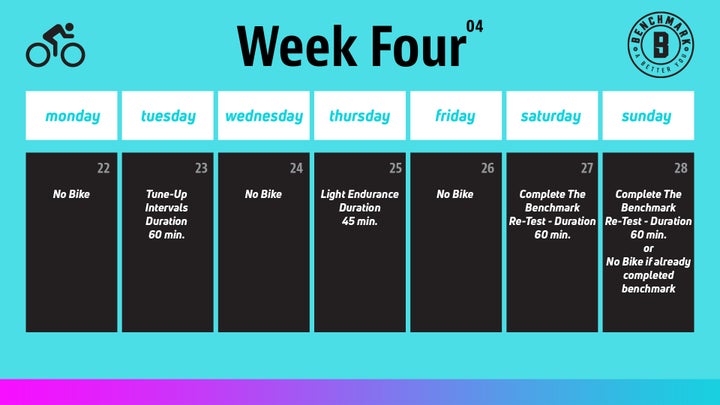New perk! Get after it with local recommendations just for you. Discover nearby events, routes out your door, and hidden gems when you sign up for the Local Running Drop.
It’s arrived: the fourth and final week of our Benchmark a Better You Bike Month challenge. Hopefully at this stage you’re feeling fitter, faster, and confident about repeating the benchmark test at the end of the week. By now you should have three solid weeks (see Week 1, Week 2, and Week 3) of bike training banked and really feeling the fitness gains as a result. Former Ironman world champion Karen Smyers has crafted two more workouts for this week—as well as the repeat of the benchmark test from Week 1—to help guide you to an improved performance at the end of the week.
Effort levels in these workouts are prescribed as a percentage of Functional Threshold Power (FTP), which is defined as the pace or power you can maintain for an all-out 60-minute time trial. If you don’t have a power meter or do not know your FTP, measure effort by Rate of Perceived Exertion (RPE) as follows:
1-3 – very easy, light aerobic, light strain on legs
4-6 – moderate, aerobic, sustainable for more than 60 minutes, moderate leg strain
6.5-7.5 – tempo, sustainable with focus; some discomfort/building fatigue/leg strain
8-9 – hard effort requiring lots of motivation to sustain even for short intervals, high strain on legs, breathing is deep and rapid
10 – anaerobic efforts, not sustainable more than a couple of minutes, legs at max effort, breathing at max if held long enough

Workout 1: Tune-Up Intervals
Duration 60 min.
Warm-up:
10 min. easy pedaling: light resistance/easy gear, 60% FTP or less, RPE 2-3
1 min. calibrate your trainer if your trainer requires it
Set 1: 16 Min. Prep Set:
Leg Speed/Pedaling Efficiency work
Start this set at 75% FTP/RPE4.5 then add 5% each set (RPE5 >>6). You can use an ergometer which will adjust the resistance when you increase your cadence to keep the power constant. If you don’t have an ergometer, use one gear easier for every 5 rpms higher to keep power constant.
4 x [2 min. @ 95 rpms; 30 sec. @ 100 rpms; 30 sec. @ 105 rpms; 30 sec. @ 110 rpms; 30 sec. @ 115 rpms]
Rest 1 min. at end of set, then do 2 min. easy pedal at your choice of rpms @ 55-65% FTP.
NOTE: Each time you settle in to a new higher cadence after the initial acceleration in leg speed, practice relaxing and letting your legs float around the circle rather than trying to “muscle” your way through it.
Set 2: 3 Min. Pep It Up Set
3 x [30 sec. acceleration to 100-110% in TT gear, 30 sec. easy spin in easy gear]
Rest 1 min. at end of set, then do 2 min. easy pedaling at your choice of rpms @ 55-65% FTP
Main Set:
5 x [1.5 min. With 1.5 min. rest between intervals]
Use your TT gear for all intervals (except for the 3rd) and adjust your cadence to put out the target power. Pedal easily during the rest intervals at below 50% FTP—don’t just sit still.
1st: 100% FTP (RPE 7.5)
2nd: 105% FTP (RPE 8)
3rd 110% FTP in one gear harder than TT gear (RPE 8.5)
4th: 115% FTP (RPE 9)
5th 120% FTP (RPE 9.5)
NOTES:
- Heart rate doesn’t have time to adjust to reflect your effort so don’t pay attention to HR on this set
- Because the intervals are much shorter than last week, you can do 5% higher each interval and get a taste or feel for the intensity without the build-up of fatigue. This will make for a good tune-up for the Benchmark TT at the end of the week.
- You should feel a little accumulation of lactate on the last 2 intervals as you are over your anaerobic threshold. Be aware of this feeling as you want to avoid it until the last few minutes of the Benchmark TT.
Cool-down
9 min. easy
Workout 2: Light Endurance
Duration 45 min.
Warm-up:
6 min. easy pedaling, light resistance/easy gear, 60% FTP or less, RPE=2-3, and include
2 x -single-legged drills as 3 x (20 sec. one leg/10 sec. both legs/20 sec. other leg/10 sec. both legs)
Calibrate your trainer if your trainer requires it.
Main Set:
3 x 12 min. broken into segments as 5 min./4 min./3 min. segments with 1 min. Easy between sets, as follows:
Set 1: 5 min. @ 70% FTP
4 min. @ 70% FTP +5w
3′ @ 70% FTP +10w
(all at ideal rpms)
Rest 1 min. easy spin
Set 2: hold 75% FTP for:
5 min. @ 100 rpms
4 min. @ 95 rpms
3 min. @ 90 rpms
Rest 1 min. easy spin
Set 3: hold 80% for:
5 min. @ 80 rpms
4 min. @ 85 rpms
3 min. @ 90 rpms
Cool-down:
1 min. easy spin
NOTES:
- This workout is all in the moderate range. It is not too taxing so you can be rested for a good effort for your Benchmark test at the end of the week.
- Ideal rpms refers to the cadence that feels most comfortable to you when you are pushing hard (like during the Benchmark TT).
Workout 3: The Benchmark Re-Test
Duration 60 min.
Warm-up:
Before your test, warm up as you did before the initial test as described below.
10 min. easy pedaling: light resistance/easy gear, 60% or less, PE=2-3
3 min. drills: 3 x -single-legged drills as 3 x (20 sec. one leg/10 sec. both legs/20 sec. other leg/10 sec. both legs)
Calibrate your trainer if your trainer requires it.
10 min. Prep Set:
Increase your heart-rate, get your leg muscles supple and warm
5 x 1 min. @ moderate rpms/moderate resistance
1 min. @ fast rpms/light resistance
Notes: if you have a power meter and know your zones, do this at 70-75% of your Functional Threshold Power (FTP). Moderate pedaling should be between 80-90 rpms. Fast pedaling should start at about 5-10 rpms faster than your moderate and increase each of the five segments so you may get to 110-120 rpms by the 5th 1 min. interval. If you have ergometer mode on your trainer, it works well for this set.
Re-calibrate while your wheel is warm if your trainer requires it.
5 min. Prep Set 2:
3 x 1 min. @ 90%, 100%, 110% or at RPE 7, 8, 9; rest 30 sec. easy between each
Rest or spin easy for several minutes before embarking on the main set.
Main Set:
10-mile time trial: Repeat the same course you used for your initial benchmark test. Cover the distance as fast as you can but be sure to pace yourself. A good strategy might be to start at the same speed or power as you averaged at the beginning of the month, but bring up the pace a little bit after you are one third, one half, or three-quarters of the way through depending on how strong you feel.
- If you did not have distance or power on your trainer, bike for 25’ in your TT gear and try to hold your TT ideal cadence or faster
- Record your time and speed (mph)
- Other data to record if you can:
- average and max heart-rate
- average power: you can recalculate your FTP as 92% of this (assuming you finished in the 25-36 min. range)
- best 3 min. power and at what point it occured
- average rpms (this is what you perceive your “ideal” cadence to be—this may change as we work on your cadence range so adjust what your “ideal” is according to your body feedback as your training progresses
Cool-down:
3-5 min. until your heart-rate and breathing returns to an easy level and any heaviness in your legs has dissipated.
Here are all the ways you might see improvements between your tests:
- Higher average mph (which also means a faster time for the distance)
- Holding a higher average power over the distance
- Having a lower average heart-rate but the same time (which means you did it more efficiently but maybe your legs weren’t ready to crank up the power today)
- Holding a higher cadence in the same gear you used for both tests (this would equate to a faster time and more power if you could measure it)
- Achieving a higher max heart-rate can mean your legs are stronger (or less of a limiter) so you accessed more of your aerobic potential
- Better pacing: maybe you learned that your best effort doesn’t usually result from doing your highest power in the first three minutes of the test.
What to do with the results:
- If you improved your average power, you should bump up your FTP to 92% of this new average (and all your zones will increase accordingly)
- If you improved your mph, you can train at a higher speed for each zone
- Bottom line: keep pushing yourself at the proper Perceived Exertion. As the legend Greg Lemond noted, “It doesn’t get easier, you just go faster!”
- Even small improvements add up over time—if you include a hard interval workout, a couple of longer endurance sessions and use a range of cadences to work on your limiters every week, you will see big results over time!
Karen Smyers won the Ironman World Championships in Kona, Hawaii, in 1995. You can find more of her bike coaching magic via her bike classes over Zoom. Contact her at mkandks@comcast.net to find out more.
